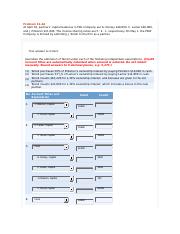What is Double Entry Accounting & Bookkeeping? Example Explanation

This complexity can be time-consuming as well as more costly; however, in the long run, it is more beneficial to a company than single-entry accounting. For instance, if a business takes a loan from a financial entity like a bank, the borrowed money will raise the company’s assets and the loan liability will also rise by an equivalent amount. If a business buys raw materials by paying cash, it will lead to an increase in the inventory (asset) while reducing cash capital (another asset). Because there are two or more accounts affected by every transaction carried out by a company, the accounting system is referred to as double-entry accounting. Just as assets are on the left side (or debit side) of the accounting equation, the asset accounts in the general ledger have their balances on the left side.
What is your current financial priority?

The first entry to the general ledger would be a debit to Cash, increasing the assets of the company, and a credit to Equity, increasing Lucie’s ownership stake in the company. Double-entry accounting also serves as the most efficient way for a company to monitor its financial growth, especially as the scale of business grows. The total amount of the transactions in each case must balance out, ensuring that all dollars are accounted for. Debits are typically noted on the left side of the ledger, while credits are typically noted on the right side. If your business is any more complex than that, most accountants will strongly recommend switching to double-entry accounting.
Using Accounting Software
(Some corporations have preferred stock in addition to their common stock.) Shares of common stock provide evidence of ownership in a corporation. Holders of common stock elect the corporation’s directors and share in the distribution https://www.kelleysbookkeeping.com/what-receipts-to-save-for-taxes-do-s-dont-s/ of profits of the company via dividends. If the corporation were to liquidate, the secured lenders would be paid first, followed by unsecured lenders, preferred stockholders (if any), and lastly the common stockholders.
Create a TechRepublic Account
Credits add money to accounts, while debits withdraw money from accounts. If you’d rather not have to deal with accounting software at all, there are bookkeeping services like Bench (that’s us), that use the double-entry system by default. “It was just a whole revolution in the way of thinking about business and trade,” writes Jane Gleeson-White of the popularization of double-entry accounting in her book Double Entry. Noting these flaws, a group of accountants—in 12th century Genoa, 13th century Venice, or 11th century Korea, depending on who you ask—came up with a new kind of system called double-entry accounting. In this article, we’ll explain double-entry accounting as simply as we can, how it differs from single-entry, and why any of this matters for your business.
Example 3: Paying for Business Expenses
However, it does not provide a complete picture of a business’s financial position. As a result, it’s ill-advised for businesses needing richly detailed financial statements. Likewise, this system is inadequate if you oversee many assets or liabilities, such as accounts payable and large https://www.online-accounting.net/ amounts of inventory. A listing of the accounts available in the accounting system in which to record entries. The chart of accounts consists of balance sheet accounts (assets, liabilities, stockholders’ equity) and income statement accounts (revenues, expenses, gains, losses).
A transaction in double-entry bookkeeping always affects at least two accounts, always includes at least one debit and one credit, and always has total debits and total credits that are equal. The purpose of double-entry bookkeeping is to allow the detection of financial errors and fraud. Double-entry accounting is a bookkeeping system requiring every financial transaction to be recorded twice (once as a debit and once as a credit) and in at least two accounts.
- The other one will be forwarded to the tax department (to make sure that income taxes are paid on time).
- The double-entry system has two equal and corresponding sides, known as debit and credit; this is based on the fundamental accounting principle that for every debit, there must be an equal and opposite credit.
- Amanda Bellucco-Chatham is an editor, writer, and fact-checker with years of experience researching personal finance topics.
- Accounting software automates the process so you don’t have to think about ledgers or T accounts.
- Double-entry bookkeeping was developed in the mercantile period of Europe to help rationalize commercial transactions and make trade more efficient.
The other one will be forwarded to the tax department (to make sure that income taxes are paid on time). Also, an entry for the same amount is made on the credit side of the Cash In Hand Account because cash is an asset and is decreasing. An entry of $500 is made on the debit side of the Capital Account because the owner’s capital in the business has been reduced. For example, consider the entries resulting from an approved expense claim. The amounts are large, so perhaps the expenses were incurred by a senior manager or just possibly a journalist.

To start using a double-entry bookkeeping system, you’ll want to upgrade from an Excel spreadsheet. Using an accounting software or service is a great idea to save you from making costly errors and spending too much time with this type of financial accounting. If the accounting equation isn’t balanced at any point, then a problem has occurred. For comparison, a single-entry system doesn’t sport similar checks and balances. In this accounting system, every debit entry begets a corresponding credit entry, and vice versa. This pairing ensures that every aspect of a business is properly accounted for.

For the borrowing business, the entries would be a $10,000 debit to “Cash” and a credit of $10,000 in a liability account “Loan Payable”. For both entities, total equity, defined as assets minus liabilities, has not changed. Double-entry bookkeeping, also known as double-entry accounting, is a method of bookkeeping that relies on a two-sided accounting entry to maintain financial information. Every entry to an account requires a corresponding and opposite entry to a different account. The double-entry system has two equal and corresponding sides, known as debit and credit; this is based on the fundamental accounting principle that for every debit, there must be an equal and opposite credit.
An important point to remember is that a debit or credit does not mean increase and decrease, respectively. However, a simple method to use is to remember a debit entry is required to increase an asset account, while a credit entry is required to increase a liability account. The asset account “Equipment” increases by what is irs form w $1,000 (the cost of the new equipment), while the liability account “Accounts Payable” decreases by $1,000 (the amount owed to the supplier). You enter a debit (DR) of $1000 on the right-hand side of the “Equipment” account. To balance the accounts, you enter a credit (CR) of $1000 in the “Accounts Payable” account.
You simply record the income that comes in and the expenses that go out. All of these debits and credits make the double-entry system time-consuming. But if you have lots of money flowing, even a few extra seconds per transaction can add up quickly.
With a single-entry accounting system, you’d record the charge in just one place alongside any other business transactions. There’d be no need to debit and credit two separate ledgers like you would with double-entry accounting. In keeping with double entry, two (or more) accounts need to be involved. Because the first account (Cash) was debited, the second account needs to be credited.

